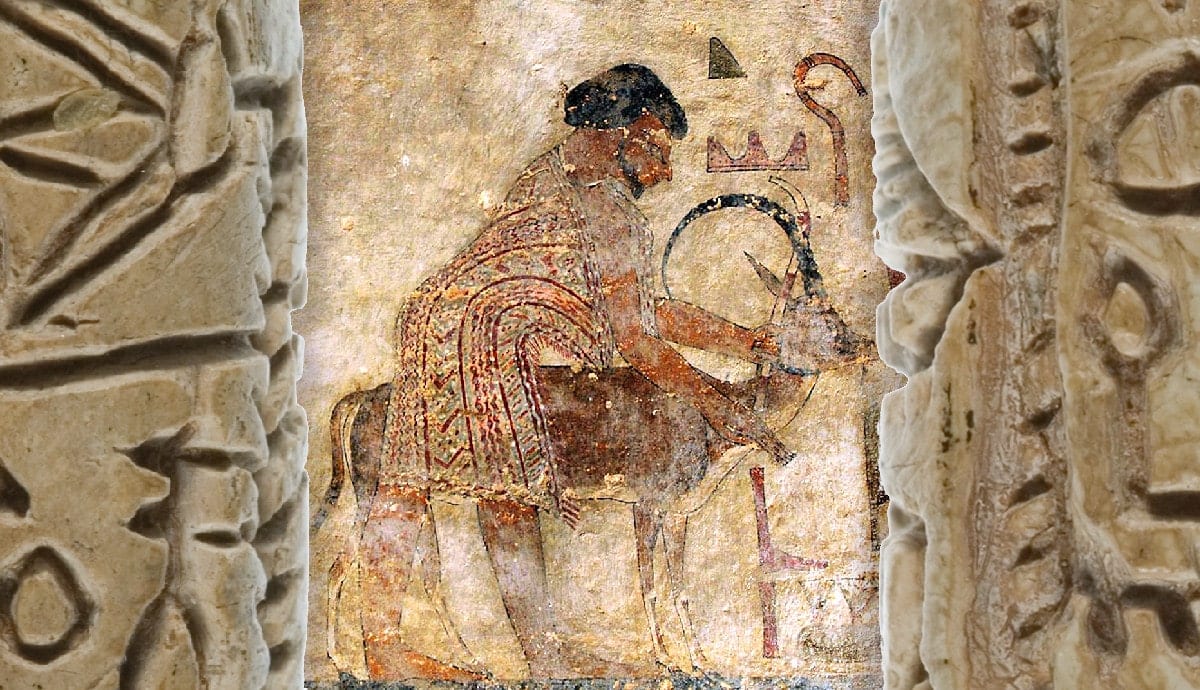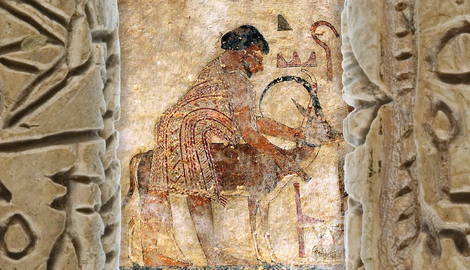
Records like those of Manetho, a renowned 3rd century BC Greco-Egyptian priest and historian, state that the Hyksos, a Semitic/Western Asiatic people, invaded the Nile Delta and proceeded to oppressively and cruelly govern the country during what is known as the Second Intermediate Period of ancient Egypt. The Egyptians favored writing about times when they were not in control of their own country as full of darkness and turmoil. However, evidence indicates that there was an influx of immigrants such as Hyksos, Semitic and West Asian peoples into the Egyptian region who integrated with the local populations for generations before the collapse of the Middle Kingdom.
Long before the Hyksos took over, Middle Kingdom rulership was already weakening. The 13th dynasty failed to maintain control of the country from Itjtawy and a stronger power rose to replace it. Although the Hyksos were foreigners, archaeological evidence indicates that they showed respect toward the religion and culture of Egypt, even going so far as to combine art styles and adopt Egyptian royal titulary.
The 14th dynasty of the Second Intermediate Period

Egypt’s 14th dynasty was comprised of a series of rulers that governed the Nile Delta region. Sometimes this dynasty is combined with the earlier Middle Kingdom dynasties, but it was at least partially concurrent with the 13th dynasty based in Memphis and the later 15th dynasty. Unfortunately, very little is known about this period; even its chronology is debated (between 75 and 150 years). The order of rulers for this dynasty is established by the Turin Royal Canon and is generally accepted as correct.
Dynasty 15: The Hyksos

In Manetho’s Aegyptiaca, the term Hyksos is used ethnically to designate people of West Semitic/Levantine origin. It comes from the Greek Ὑκσώς (Hyksôs), derived from the Egyptian ??? (ḥḳꜣ-ḫꜣswt, “heka khasut”), meaning “ruler of foreign lands”. One of the earliest uses of the word “Hyksos” can be found in the early Middle Kingdom tomb of Khnumhotep II. Hyksos rulers were constantly adjusting their identities as the situation necessitated, emphasizing Egyptian traditions or their Semitic origins.
The Hyksos Period marks the first in which Egypt was ruled by foreign rulers. They did not, however, control all of Egypt. Instead, they coexisted with the 16th through the 17th dynasties that were based in Upper Egypt during the Second Intermediate Period. The Hyksos ruled the Nile Delta region from their capital at Avaris where they practiced their own customs while also incorporating Egyptian traditions. They even introduced some of their own technological innovations to the Egyptians, such as the horse and chariot, glass manufacturing, and some modern Bronze Age weaponry.
Egypto-Hyksos Cultural Blending

Archaeological excavations at Tell el-Dab’a in Avaris have shown that Levantine immigrants had been coming to the Delta region for centuries, peaking in the mid-12th century through the early part of the Second Intermediate Period. Further examination of the extant architecture, religion, food, and material culture such as the 12th century statue head of an Asiatic official above showed a distinct blending of elements and/or techniques from both peoples, suggesting that Tell el-Dab’a was a peaceful, amalgamated community.
The statue pictured above was also found at Tell el-Dab’a and bears both Levantine and Egyptian elements. The fully reconstructed statue represents an important official who served under a Middle Egyptian king. He is seated and holding a throw stick at his left shoulder—a traditionally Egyptian pose. However, the mushroom-like hair style and the fringed dress are plainly Levantine in style.

The Hyksos of the Second Intermediate Period adopted elements of Egyptian kingship including royal titles, sacred inscriptions, and worshipping the Egyptian pantheon. These people also introduced an influx of technologies and practices including importing pottery styles, ceremonial architecture, dress codes, and non-Egyptian burial customs and religious practices. Some of these practices also show clear foreign (Near Eastern) influence. For example, temples constructed at Avaris beginning around 1800 BC showed little architectural similarities to contemporaneous Egyptian religious structures. They also chose to maintain the heka khasut title with their Semitic personal names.
The Hyksos were also in contact with a number of Near Eastern civilizations as evidenced by a series of Akkadian seal impressions and a Mesopotamian letter. They also introduced a number of foreign gods and combined their attributes with Egyptian gods.
The 16th Dynasty Of Second Intermediate Period Egypt

During the Second Intermediate Period, unlike the normal progression of one dynasty moving into the next, Dynasty 16 existed concurrently with part of the 15th dynasty. They ruled the Theban region in Upper Egypt for approximately seventy years during the Second Intermediate Period in between the Nubians to the south and the Hyksos to the north. The kings of this dynasty attempted to wage war against the Hyksos, but were defeated rather quickly. Hyksos armies seized more and more land from the 16th dynasty rulers, eventually threatening and then conquering their capital.
The Mysterious Abydos dynasty

Scholars continue to debate this dynasty’s existence in the first place, but it is hypothesized to have been a short-lived local dynasty that ruled over part of Upper Egypt from Abydos. It was contemporaneous with the 15th and 16th dynasties and dates from approximately 1650 to 1600 BC. The Turin King List, the most extensive kings list compiled by the ancient Egyptians, records the names of sixteen kings thought to belong to this mysterious dynasty.
Dynasty 17: The Rebellions

The 17th dynasty is the final dynasty of the Second Intermediate Period of Egypt and dated from approximately 1580 to 1550 BC. The Hyksos took over again, but only for a brief time. During the second half of this dynasty, the Egyptians had begun to become more restless and unhappy with the foreign rulership. This is made clear by their use of the word chief instead of king, a term used for non-Egyptian rulers. Rulers of local kingdoms began to resist Hyksos control through rebellions and warfare, but failure preceded success.
One such local ruler by the name of Seqenenre Tau went up against the Hyksos in battle and lost. His mummy shows a series of head wounds. Bioarchaeologists have determined not only that the fatal blow came from an axe but also that the murder weapon was a duck-billed Hyksos axe, which proves that this leader was actually on the battlefield with his soldiers when he died.

Following Seqenenre Tau, Kamose, the final king in a series of native Theban kings, also conducted hostilities against the Hyksos. He believed that Avaris was Egyptian territory and would not allow them to keep it. Kamose and the other dissatisfied rulers of the Second Intermediate Period modified the definition of Egyptian territory from the king’s personal boundaries (the land the king controls) to Egypt’s boundaries (all of ethnic Egypt and Egyptian soil). Since the Hyksos were settled on Egyptian land, native Egyptian kings had every right to reclaim it.
He also erected multiple stelae at the Temple of Karnak that recorded his own campaign, further vilifying the Hyksos with propagandistic rhetoric. By the end of his third year as king, Kamose had also campaigned against Kush to try and regain control of Nubia and get Egypt back. This was a decisive action because Egypt sourced its gold from Nubia and controlling Nubia meant having control over wealth which would redefine all Egyptian foreign relations. Unfortunately, the king died of unknown causes after only three years on the throne, which was then handed to his younger brother, Ahmose I.
The End of a Foreign Era

Ahmose finally completed the conquest and expulsion of the Hyksos from the Delta region, reunified Egypt, and reasserted Egyptian power over its former subject territories (such as Nubia). Ahmose’s victory reliefs detail a hostile and bloody ending to the foreigners’ reign with depictions of battle scenes complete with severed hands. A soldier under the command of Ahmose I, Amenhotep I, and Thutmose I recorded the destruction of the Hyksos capital and ejection of its people in the Autobiography of Ahmose, son of Ibana. But there is no solid evidence to support this kind of damage. There is also evidence to suggest that the Hyksos may not have been unceremoniously tossed out of Egypt en masse; pottery uncovered at Avaris suggests that some may have stayed behind and lived there into the New Kingdom.

In any case, it is known that Ahmose reorganized the country’s administration, campaigned in Syro-Palestine, and undertook large-scale construction projects. A simultaneously fun and sad fact is that Ahmose was actually the last naive Egyptian ruler to construct a pyramid. With the defeat of the Hyksos came the ushering in of Dynasty 18 and the beginning of the powerful age known as the New Kingdom.
The Hyksos Legacy: Egyptian Perspectives from the Second Intermediate Period and Beyond

It may come as a surprise that apart from the records of Kamose and Ahmose during active battle with the Hyksos, anti-Hyksos propaganda did not begin immediately after their supposed expulsion. Their time as the top dogs of Egypt created bitter memories for the Egyptians for centuries after their rise and fall; eventually, it began again under Hatshepsut, one of the most famous pharaohs in Egyptian history and continued for many centuries. Their names were gauged or excluded from many temple king lists, historians like Manetho (3rd century BC) and Josephus (1st century BC/AD) wrote negatively about the Hyksos.

Moreover, it is quite possible that the generations of resistance and warfare against the Hyksos were the major driving force behind Egypt’s new military culture. After their defeat, New Kingdom pharaohs regularly sent their professional armies to launch regular conquests of foreign territories which extended the Egyptian empire from Nubia all the way to the southern border of the Hittite Empire.
Despite the inconsistencies between the official record and the archaeological one, Hyksos rulership affected New Kingdom culture, language, foreign policy, and even kingship. This distinguished period was marked by the arrival of new technologies and cultural immersion into Egypt. Although the Egyptians recorded otherwise, the Hyksos of the Second Intermediate Period had a huge impact, even indirectly laying the foundations for the Egyptian Empire.










